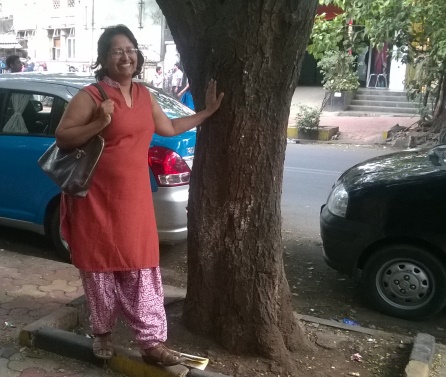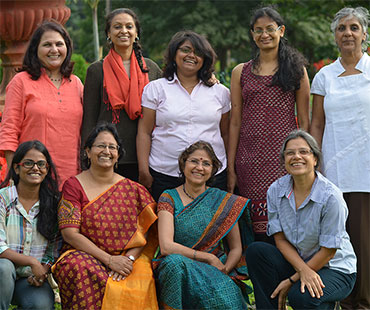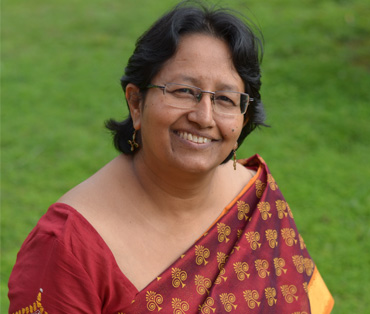Knowing Your Body Will Set You Free
Dr. Shaibya Saldanha, a practicing gynaecologist and mother of two, is a trainer and speaker on issues of health, sexuality and child sexual abuse in the country. Since 2000, Dr. Saldanha and the ‘Enfold Proactive Health Trust’, the Bangalore-based organization that she co- founded have been trying to set the record straight on health and sexuality in India, one training group at a time.
It has not been the easiest of journeys. But Enfold has been uncommonly determined in airing out orthodox cultural mores, defying rigid patriarchal structures, talking taboos, opening up conversations and ‘creating safe spaces’. During the last 14 years, they have trained a good sized ‘community’ of children, parents, teachers, lawyers, doctors, social workers and police personnel across India on various aspects of the issue from sexuality education to personal safety to care for abuse victims.
The Idea of Enfold:
“I was approached by a girl of around 26 or 27 years of age who asked me to remove her uterus. I asked her why she wanted to do that.”
“Terrible mood swings” she said. Every time she was expecting her periods, her uncontrollable anger would be directed at her family, particularly at her younger brother. As soon as her periods started, the anger subsided without any rationale. Her behavior was so extreme that her family was beginning to avoid her.
“I first told her that just before your periods, your body is actually telling you something about yourself. I explained to her that during this time, the body thinks that it may be pregnant,” says Dr. Saldanha.“It behaves selfishly at the time because it is thinking of ‘yourself’ and your safety above anything else at the time. It is the natural way.”
“I asked her about her family which seemed to be the average traditional unit. I asked her if her parents were forcing her to get married by telling her that she was getting too ‘old’. I asked her to think if her brother’s birth, obviously celebrated in the family as the ‘birth of a boy’, made her feel slighted, as an older sibling and as a girl. I wanted her to think on her dynamics with the rest of the family.”
“The girl left and 8 months later she returned to see me. She told me that she had been thinking about the things I had pointed out to her. Somehow her uncontrollable mood swings had settled and very much in control. She had resolved her own issue.”
“Now this set me thinking – it was knowledge that solved the girl’s issue. Basic knowledge about yourself and your body has the ability to bring change. It could even cure a health issue. That idea of the possibility of knowledge was the foundation for Enfold.”
Talking Health and Sexuality
Dr. Saldanha admits that she made the khayali pulao (castles in the air) while Dr. Sangeeta Saksena, her long-time colleague and ENFOLD co-founder worked out the more practical implementations of their ambitious plans. At a personal level, it was rough in the beginning. Funding was tight but the two doctors were confident that they were on the right path, doing the right thing.
“We knew that there would always be food on our tables,” says Dr. Saldanha. But the newly formed organization had a bigger hurdle to face.
“It is not easy to easy to talk about sexuality in a country that confuses ignorance with innocence,” says Dr. Saldanha. “More so when the issue is something like child sexual abuse. Parents and schools weren’t very accepting of what we had to say.”
“But we wouldn’t be silent. We kept talking and talking about it. We were determined to speak out until people began to listen.”
They pursued training and speaking engagements and their advocacy with evangelical zeal and often for little money. During this time, they also had the opportunity to collaborate with Dr. Shekhar Seshadri of NIMHANS, Bangalore, one of the foremost authorities in the country on child and adolescent psychiatry, to write the popular ‘On Track’ series of books. The books attempted to teach life skills and personal safety education to children from class 3 to 9. The time spent with Dr. Seshadri and the process of writing was a great learning experience for team ENFOLD.
It was around this time that ENFOLD developed an acute focus on the issue of Child Sexual Abuse.
Working on Child Sexual Abuse
Cases of child sexual abuse had been coming to ENFOLD. The trauma inflicted by the system through which the minor victim had to go through in order to access healthcare and justice distressed the two doctors. There was a distinct lack of knowledge and sensitivity at every level in the system, from families to doctors to police personnel to social workers. There seemed to be little concern towards the security and well-being of the victim.
“The way the system worked, it was like subjecting the victim to secondary abuse,” says Dr. Saldanha.
They started to look out for a better system, one where the parties involved in dealing with cases of sexual abuse would have better communication and collaboration to reduce the trauma for victims.
Vidya Reddy of Tulir had assisted in the initial foundation of Enfold’s work in combatting CSA. She suggested that Dr. Saldhana enrol with ISPCAN in the Philippines for a course that offered doctors and social workers intensive training on how collaborative child response units (CCRU) could be developed and implemented.
“I immediately signed up,” says Dr. Saldhana. “The training I received there and witnessing first- hand the functioning of the CPU-NET team at the Phillipine General Hospital in Manila fired me up. They gave me their modules to refer to and use. But I soon realized that I would have to significantly reshape it in order for it to work within the Indian context.”
“I completed my course, returned to India and soon after that MS Ramaiah Hospital, Bangalore called on us to train their doctors and other staff in accordance with the newly developed modules.”
Setting Up the first CCRU
“For the module to work, it is not just the hospital staff who had to be trained but all groups including the police and social workers. Everybody related to the case had to be on the same page and work together with the interest and safety of the child at the heart of all procedures.”
“Police officers from the nearby police stations to the hospitals were invited for special training sessions. We introduced all the groups among themselves so they would know, recognize and work with each other.”
“The first CCRU in India was established at MS Ramaiah Hospital. Soon after, we implemented it at Baptist Hospital.The impact was immediate.”
“There was a case of three rescued minor girls who were taken to the CCRU.
We got a call from the NGO who rescued the girls. They said that the doctors took just three hours to complete all the procedures when it otherwise would take them about a day. They also mentioned that the police were polite and went an extra mile to ensure that children and the families felt secure and attended to. This was a great moment for us.”
Enfold’s fantastic work with the CCRUs caught the attention of Department of Women and Child Welfare, Karnataka. If all had gone according to plan, the state would have had, as of today, the honour of being the first state where every major government hospital had a CCRU. It would have been a landmark event in child protection in the country. But even as the UN commended Enfold’s efforts, petty bureaucracy and a single obstructive government servant made sure that the best laid plans would come undone. It was a terrible loss and a grave disappointment to all concerned.
The Way Forward
On the sunnier side of things, other states are looking to start the CCRU project with Enfold in the near future. And the trainings continue unabated.
In her mind’s eye, Dr. Saldanha has already seen the ideal future of her vision.
“There should be training institute in every district or at least state in the country where we go in and train the first few groups of doctors, social workers, police personnel, lawyers and other stakeholders. We select the ones who respond most positively and train them as Master trainers for that state. These trainers can have monthly visits to other centres and conduct training sessions where they create other trained professionals and trainers. The system is standardized and the cycle then moves ahead on its own momentum.”
“I know it sounds great but I also know that this can only happen is the government is prepared to take ownership of this system.”
So what about Enfold?
“This is not about Enfold. The system is what is important. The system is what should remain.” Dr. Saldhana has given herself till the age of 60 to make her dream of this perfect, self-sustained system come true. From the ages between 60 to 90, she sees herself in the Himalayan villages across North and North East India helping women and children access better healthcare.
Getting to 90 is the easy part. “All in my family live into their nineties,” says Dr. Saldhana. The rest is where her characteristic defiance and courage will come into play- to change the status quo and to better the system..











